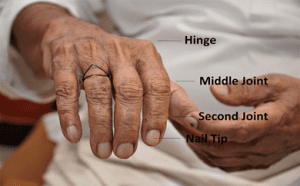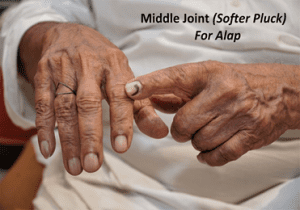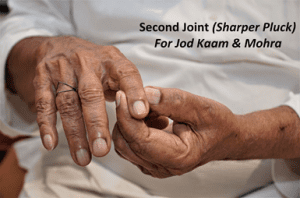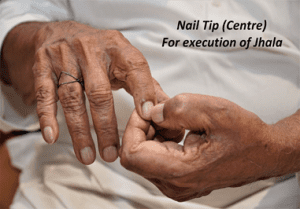Starting from main (Madhyam) string, the last two strings are chikari strings. This is a result of deep thinking and profound consideration of sound when main chikari is tuned to Sa (Shadaj) and the small chikari is tuned into upper Sa (Shadaj).
It is essential to understand the role of chikari plucked during alap, jod and jhala. Though such plucking is essentially meant to give support to the main string melody, such required support varies in different sections – details are as follows.
Before we consider different methods of plucking chikari strings, it would be necessary to understand the sources of strength which produce the pluck. Referring to the photograph, the main joint is only a hinge (mijagra) and not a source of strength. It would be noted that, there are 3 main sources of strength for plucking chikari strings.

a) During the alap, it is essential to maintain a tanpura like support, hence plucking of chikari string should not be a straight pluck but a glide from chikari strings to Gandhar & Pancham strings, followed by a pluck of the jod string. Such 2 plucks i.e. chikari along with jod create a tanpura like atmosphere – a great support to the main alap movement. To produce such tanpura like ambiance, the source of strength for plucking chikari should emanate from middle joint (refer to the photo).

b) For playing jod patterns, the chikaris are not expected to create tanpura like atmosphere but to play a role to accentuate beats used in jod execution. In fact the jod, I assume, is known by its name, as the rhythmic patterns are 1-2, 1-2 etc. The number 1 begins with main string and number 2 begins with chikari string. The source of strength for creating the required sound from the chikari should be as per second joint (refer to the photo).

c) For the jhala section, it is evident that a pattern of 1-2-3-4, 1-2-3-4 etc. is to be created. To match with the tabla theka, all beats (4) have to be of equal volume / sharpness to create rhythmic patterns creating spiritual or inward looking effect. With the required sharpness to pluck, the chikari string should utilize the strength arising from nail tip centre (refer to the photo).
